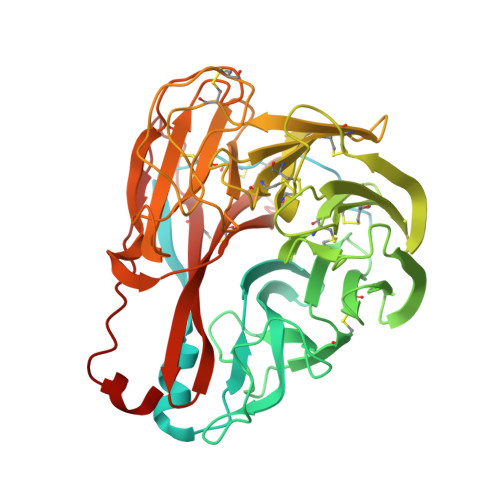Structural and inhibitor sensitivity analysis of influenza B-like viral neuraminidases derived from Asiatic toad and spiny eel.
Li, L., Chai, Y., Peng, W., Li, D., Sun, L., Gao, G.F., Qi, J., Xiao, H., Liu, W.J., von Itzstein, M., Gao, F.(2022) Proc Natl Acad Sci U S A 119: e2210724119-e2210724119
- PubMed: 36191180
- DOI: https://doi.org/10.1073/pnas.2210724119
- Primary Citation of Related Structures:
7FGB, 7FGC, 7FGD, 7FGE, 7XVR, 7XVU, 7XVV, 7XVW - PubMed Abstract:
Influenza virus neuraminidase (NA) is an important target for antiviral development because it plays a crucial role in releasing newly assembled viruses. Two unique influenza-like virus genomes were recently reported in the Wuhan Asiatic toad and Wuhan spiny eel. Their NA genes appear to be highly divergent from all known influenza NAs, raising key questions as to whether the Asiatic toad influenza-like virus NA (tNA) and spiny eel NA (eNA) have canonical NA activities and structures and whether they show sensitivity to NA inhibitors (NAIs). Here, we found that both tNA and eNA have neuraminidase activities. A detailed structural analysis revealed that tNA and eNA present similar overall structures to currently known NAs, with a conserved calcium binding site. Inhibition assays indicated that tNA is resistant to NAIs, while eNA is still sensitive to NAIs. E119 is conserved in canonical NAs. The P119E substitution in tNA can restore sensitivity to NAIs, and, in contrast, the E119P substitution in eNA decreased its sensitivity to NAIs. The structures of NA-inhibitor complexes further provide a detailed insight into NA-inhibitor interactions at the atomic level. Moreover, tNA and eNA have unique N-glycosylation sites compared with canonical NAs. Collectively, the structural features, NA activities, and sensitivities to NAIs suggest that fish- and amphibian-derived influenza-like viruses may circulate in these vertebrates. More attention should be paid to these influenza-like viruses because their NA molecules may play roles in the emergence of NAI resistance.
Organizational Affiliation:
CAS Key Laboratory of Pathogen Microbiology and Immunology, Institute of Microbiology, Chinese Academy of Sciences (CAS), Beijing 100101, China.
















